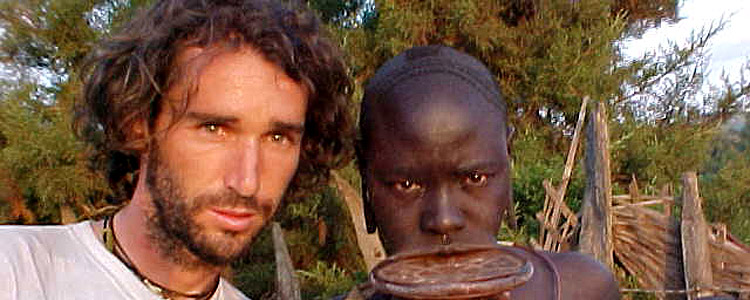Mursi women have a particular way of decorating themselves, deforming their natural appearance. By tradition, they made a cut in the lower lip of the little girls and they put a clay plate inside which will be enlarged till the moment the girls get married.
Km 25,100

People say that Ethiopia was the name that Greeks used for lands where black people live.But this part of Africa is not like other places where I’ve been: its people are different and their faces and color, too. Ethiopia is a different country, the only one in the continent that wasn’t colonized by Europeans. It has a rich history that goes back to more than 3,000 years ago and an original culture that turns it into a fascinating place.
I arrived in Ethiopia from Moyale. I was welcomed by a cold weather. It’s a high country, and while I was cycling towards the north, I was going upper and upper.
Its roads are in good condition. I remember that, tired of biking, I stopped to rest and eat something; suddenly, I got a fright: four men with machine guns appeared from the bushes and came close to me quickly. When I saw them, they were already ten meters far away from me, and I thought they were bandits from the north of Kenya.

I looked at them, not showing my fear, while I went on eating my orange, as if nothing had happened. After the traditional greeting “Salama”, we looked at each other for several seconds and, fortunately, one of them talked to me in a rough English. He was from Kenya and, as he said, they were guarding the area; luckily, they weren’t bandits. They were friendly, after all. Some days later, I knew that the Borana, the people that live in the south of Ethiopia, usually carry a gun. They explained to me that it gives them status.
Ethiopian tribes
In the south of Ethiopia there are many tribes with different dialects and their own customs. To these tribes, the cattle is their main possession, the first source of sustenance for children and young people whose feeding is based on a mixture of blood and milk, in times of lack of cereals.
When I traveled around this area, the rainy season was ending, so it was green everywhere, with different cultivations, and their rivers and lakes weren’t dry.
According to commentaries the south of Ethiopia is one of the toughest areas of Africa: its people face long draughts during a great part of the year that provokes starvation among the population. The roads are not asphalted, they are in very bad condition and that makes most of the places inaccessible.
There I met the Mursi, one of the tribes that live in the surrounding area of the Mago National Park. Women have a particular way of decorating themselves, deforming their natural appearance. By tradition, they made a cut in the lower lip of the little girls and they put a clay plate inside which will be enlarged till the moment the girls get married. The bigger the plate is, the bigger the number of cows the suitor will pay to the bride’s father.

Men paint their faces white with geometric designs and, as other groups; they practice some kind of wrestling called “surma”, which is a violent fight with long sticks, where they risk the prestige of the community. Although I just reached Yinka, in my way I met people from several tribes, as the Karo, the Hammer and the Benna.
I would have liked to stay there longer to get to know them better, but my budget forced me to go to the capital city urgently.
Straight to Addis
The following days going to Addis Ababa weren’t easy. The official language in Ethiopia is Amharic. Although many people speak different dialects according to the region, and just a few people speak English, mainly students.
In the small towns, at meal-time, there weren’t many options. The traditional meal is the injera, a kind of pancake as large as a pizza, which is made of the grain of a plant called teff. It is grey and it is served with some meat or vegetables. They eat that every day, at lunch and at dinner. I would have liked to change it a little, but almost ever that was impossible; except for that huge seven eggs omelet I ate in Konso.

Each dinner was like assembling a jigsaw puzzle, asking for something different from the traditional meal was so difficult as trying to buy it; I don’t eat meat, and the injera wasn’t enough, I needed more than that. So every time I could, I went to a Catholic Mission or a church where, after speaking to the bishop or the priest, I could stay for one night and change my menu.
But in my way, the main fact I was worried about was my finances: I was running out of money and I knew that, as every capital city, Addis would be more expensive. So I needed a sponsor.


